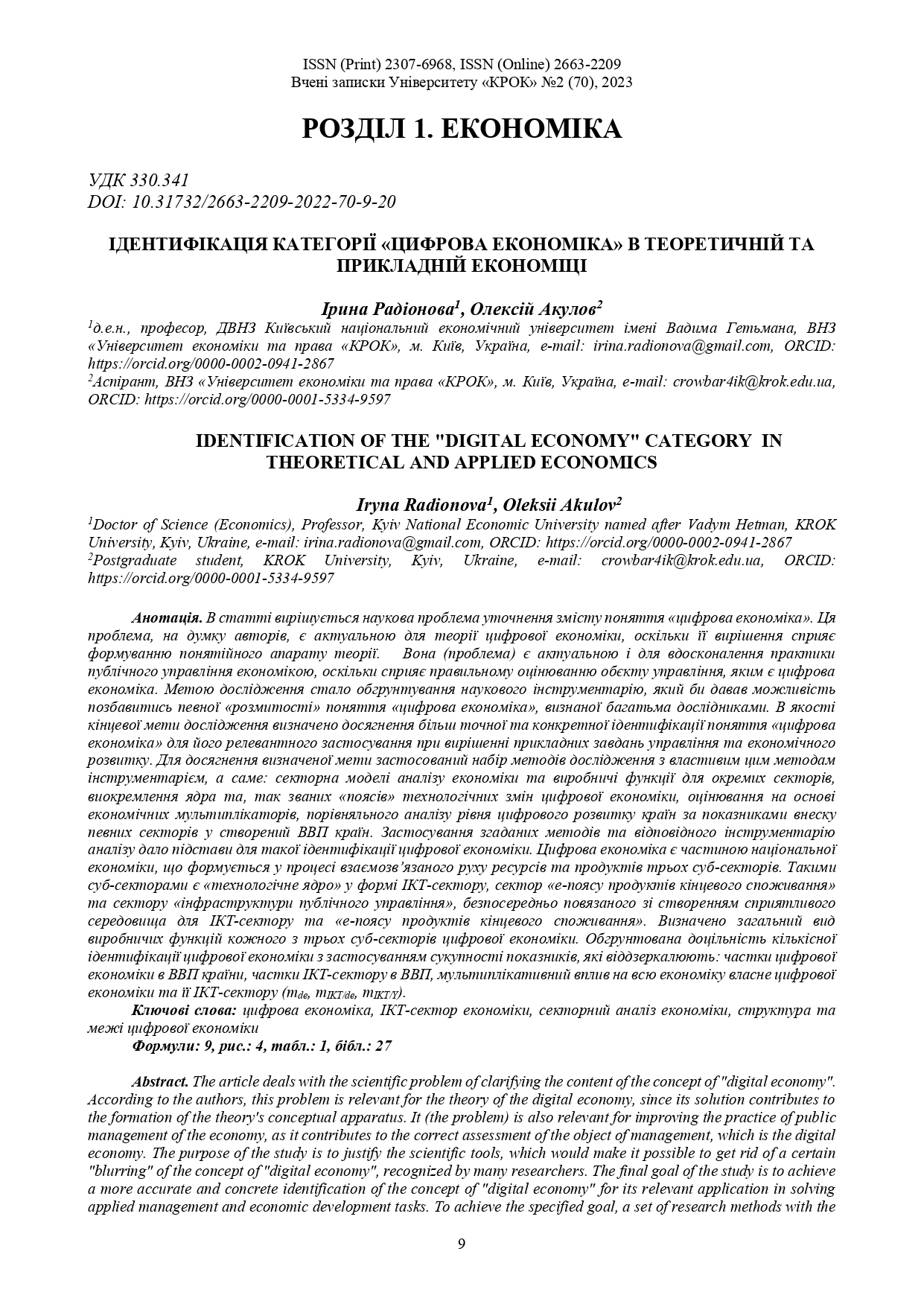IDENTIFICATION OF THE "DIGITAL ECONOMY" CATEGORY IN THEORETICAL AND APPLIED ECONOMICS
DOI:
https://doi.org/10.31732/2663-2209-2022-70-9-20Keywords:
digital economy, ICT sector of the economy, sectoral analysis of the economy, structure and boundaries of the digital economyAbstract
The article deals with the scientific problem of clarifying the content of the concept of "digital economy". According to the authors, this problem is relevant for the theory of the digital economy, since its solution contributes to the formation of the theory's conceptual apparatus. It (the problem) is also relevant for improving the practice of public management of the economy, as it contributes to the correct assessment of the object of management, which is the digital economy. The purpose of the study is to justify the scientific tools, which would make it possible to get rid of a certain "blurring" of the concept of "digital economy", recognized by many researchers. The final goal of the study is to achieve a more accurate and concrete identification of the concept of "digital economy" for its relevant application in solving applied management and economic development tasks. To achieve the specified goal, a set of research methods with the tools inherent in these methods is applied, namely: sectoral models of economic analysis and production functions for individual sectors, identification of the core and so-called "belts" of technological changes in the digital economy, evaluation based on economic multipliers, comparative analysis the level of digital development of countries according to indicators of the contribution of certain sectors to the created GDP of countries. The application of the mentioned methods and the corresponding tools of analysis gave grounds for such identification of the digital economy. The digital economy is part of the national economy, which is formed in the process of interconnected movement of resources and products of three sub-sectors. Such sub-sectors are the "technological core" in the form of the ICT sector, the "consumer e-belt" sector and the "public administration infrastructure" sector, which is directly related to the creation of an enabling environment for the ICT sector and the "consumer e-belt ". The general type of production functions of each of the three sub-sectors of the digital economy is determined. Reasoned feasibility of quantitative identification of the digital economy using a set of indicators that reflect: the share of the digital economy in the GDP of the country, the share of the ICT sector in the GDP, the multiplier effect on the entire economy of the digital economy itself and its ICT sector (mde, mIKT/de, mIKT/Y).
Downloads
References
Elmasry, T., Benni, E., Patel, J., & Aus dem Moore, J. P. (2016). Digital Middle East: Transforming the region into a leading digital economy. https://www.mckinsey.com/featured-insights/middle-east-and-africa/digital-middle-east-transforming-the-region-into-a-leading-digital-economy
Bukht, R., & Heeks, R. (2017). Defining, Conceptualising and Measuring the Digital Economy. Development Informatics Working Paper no. 68. http://dx.doi.org/10.2139/ssrn.3431732
Unold, J. (2003). Basic Aspects of the Digital Economy. Acta Universitatis Lodziensis. Folia Oeconomica, 167, 1–21. https://dspace.uni.lodz.pl/xmlui/bitstream/handle/11089/7061/41-49.pdf
(n.d.). Digital Economy. ICCWBO. https://iccwbo.org/global-insights/digital-economy/
UNCTAD. (2021). Digital Economy Report 2021. United Nations. https://unctad.org/system/files/official-document/der2021_en.pdf
Saffo, P. (2016). Get ready for a new economic era. http://www.saffo.com/wp-content/uploads/2016/06/McKinsey-Creator.pdf
Wu, D. (2022). Inside China's Surveillance State, Built On High Tech And A Billion Spies. https://worldcrunch.com/culture-society/china-surveillance-cameras
Mutula, S.M. (2009). Digital Economies: SMEs and E-Readiness. 1-338. https://doi.org/10.4018/978-1-60566-420-0
OECD. (2020). OECD Digital Economy Outlook 2020. OECD Publishing, Paris. https://doi.org/10.1787/bb167041-en
Oleshko, T. I., Kasianova, N. V., Smerichevskyi, S. F. ta in. (2022). Tsyfrova ekonomika: pidruchnyk. Kyiv: NAU. https://er.nau.edu.ua/handle/NAU/54129
Romer, P.M. (1989). Endogenous Technological Change. National Bureau of Economic Research. NBER Working Paper Series no. 3210. https://www.nber.org/system/files/working_papers/w3210/w3210.pdf
OECD. (2019). Roles and responsibilities of actors for digital security. OECD Publishing, Paris. OECD Digital Economy Papers no. 286. https://doi.org/10.1787/3206c421-en
OECD. (2014). The digital economy, new business models and key features, in Addressing the Tax Challenges of the Digital Economy. OECD Publishing, Paris, 2014. https://doi.org/10.1787/9789264218789-7-en.
Lloyd, B. (2021). How do Governments add value to society? or What are Governments for?. Academia Letters, Article 1208. https://doi.org/10.20935/AL1208
Lakatos, I. (1987). The Methodology of Scientific Research Programmes: Philosophical Papers (J. Worrall & G. Currie, Eds.). Cambridge: Cambridge University Press. https://doi.org/10.1017/CBO9780511621123
U.S. Bureau of Economic Analysis (BEA). (2022). Digital Economy Data 2005-2021. U.S. Department of Commerce. table 2. https://www.bea.gov/system/files/2022-11/DigitalEconomy_2005-2021.xlsx
U.S. Bureau of Economic Analysis (BEA). (2020). Digital Economy Data 2005-2018. U.S. Department of Commerce. table 2. https://www.bea.gov/system/files/2020-08/Digital-Economy-Tables-August-2020.xlsx
UNDP. (2022). China in Numbers (2022). United Nations. https://www.undp.org/china/publications/china-numbers-2022
Statista Search Department. (2023). Share of the digital economy in the GDP of China from 2015 to 2021. Statista. https://www.statista.com/statistics/1250092/china-digital-economy-gdp-share
Highfill, T., & Surfield, C. (2022). New and Revised Statistics of the U.S. Digital Economy, 2005–2021. U.S. Bureau of Economic Analysis (BEA). https://www.bea.gov/system/files/2022-11/new-and-revised-statistics-of-the-us-digital-economy-2005-2021.pdf
CAICT. (2020). Digital Economy Development in China (2020) (p.2). MIIT China. Retrieved April 25, 2023, from http://www.caict.ac.cn/english/research/whitepapers/202007/P020200728343679920779.pdf
Manyika, J., Chui, M., Bughin, J., Dobbs, R., Bisson, P., & Marrs, A. (2013). Disruptive technologies: Advances that will transform life, business, and the global economy. McKinsey Global Institute. http://surl.li/irhin
Woetzel, J., Madgavkar, A., Seong, J., Manyika, J., Sneader, K., Tonby, O., … Gupta, S. (2018). Outperformers: High-growth emerging economies and the companies that propel them. McKinsey Global Institute. http://surl.li/irhip
European Central Bank. (2020). The digital economy and the euro area. ECB Economic Bulletin. https://www.ecb.europa.eu/pub/economic-bulletin/articles/2021/html/ecb.ebart202008_03~da0f5f792a.en.html
Eurostat. (n.d.). Percentage of the ICT sector in GDP (online data code: ISOC_BDE15AG, view: DEFAULT). European Union. Retrieved April 25, 2023, from https://ec.europa.eu/eurostat/databrowser/view/ISOC_BDE15AG/default/table?lang=en&category=isoc.isoc_se
Derzhavna sluzhba statystyky Ukrainy. (2023). Valovyi vnutrishnii produkt (u faktychnykh tsinakh), 2015-2022 rr. Retrieved April 25, 2023, from https://ukrstat.gov.ua/operativ/operativ2003/vvp/vvp_kv/vvp_kv_u/arh_vvp_kv.html
NABU. (2023). VVP Ukrainy za rokamy. Retrieved April 25, 2023, from https://nabu.ua/ua/vvp-2.html

Downloads
Published
How to Cite
Issue
Section
License

This work is licensed under a Creative Commons Attribution-NonCommercial 4.0 International License.

